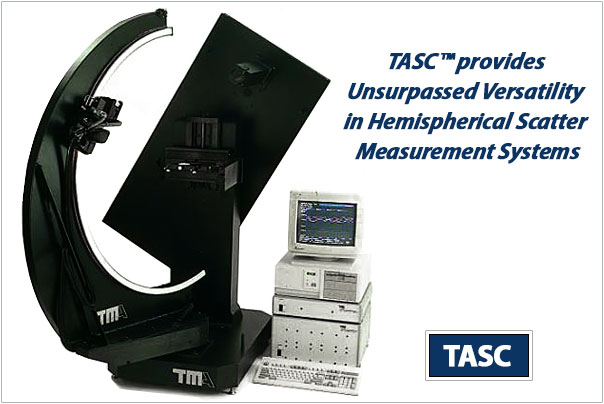The TASC Scatterometer
Hemispherical scatter measurements with an option for polarization control

A highly refined and accurate scatterometer that is suitable for a large variation of industrial and non-industrial applications!
Purchase or Enquire:
520-275-2644
john@thescatterworks.com
Downloads:
| Download the TASC Scatterometer Data Sheet |
Introduction:
TASC™ provides unsurpassed versatility in hemispherical scatter measurement systems. The polarization transformation option allows measurement and analysis of Stokes vectors and Mueller matrices. The retro-scatter assembly option provides sensitive measurement of energy scattered directly back along the incident beam.
System Description
The TSW TASC™ Scatterometer uses light energy from lasers or broadband source monochromators, as a non-contact probe to measure scattered light from a wide variety of materials including liquids and powders. Powerful measurement techniques including polarization transformations and retro-scatter options provide the tools you need for complete material characterization. The sample is mounted horizontally on stages capable of moving in X and Y and/or rotation. The incident angle can be set to any angle up to 85 deg from surface normal. TASC can be programmed to scan in the hemisphere above (for reflectance) or below (for transmission) with resolutions down to 0.001 per step.
Powerful software simplifies sample and scan set-up and stores the information in retrievable scan configuration files. BRDF data can be used to calculate TIS, Total Hemispherical Reflectance, PSD, and RMS roughness. Polarization transformation measurements calibrate automatically and can be analyzed as Stokes vectors or Mueller matrices. ASTM Standard data files are in a format easily read by other programs for expanded analysis capabilities.
The TASC Scatterometer Additional Information:
System Description
The TSW TASC™ Scatterometer uses light energy from lasers or broadband source monochromators, as a non-contact probe to measure scattered light from a wide variety of materials including liquids and powders. Powerful measurement techniques including polarization transformations and retro-scatter options provide the tools you need for complete material characterization. The sample is mounted horizontally on stages capable of moving in X and Y and/or rotation. The incident angle can be set to any angle up to 85 deg from surface normal. TASC can be programmed to scan in the hemisphere above (for reflectance) or below (for transmission) with resolutions down to 0.001 per step.
Powerful software simplifies sample and scan set-up and stores the information in retrievable scan configuration files. BRDF data can be used to calculate TIS, Total Hemispherical Reflectance, PSD, and RMS roughness. Polarization transformation measurements calibrate automatically and can be analyzed as Stokes vectors or Mueller matrices. ASTM Standard data files are in a format easily read by other programs for expanded analysis capabilities.
